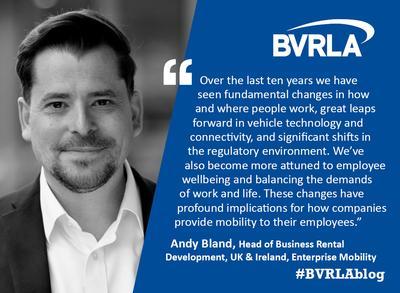Andy Bland, Head of Business Rental Development, UK and Ireland at Enterprise Mobility explains how businesses must rethink mobility strategies to align with broader objectives. By moving beyond transactional fleet management and embracing flexible, value-driven mobility partnerships, organisations can enhance efficiency, reduce risk, and unlock long-term growth opportunities.

Over the last ten years we have seen fundamental changes in how and where people work, great leaps forward in vehicle technology and connectivity, and significant shifts in the regulatory environment. We’ve also become more attuned to employee wellbeing and how organisations can enable people to better balance the demands of work and life.
These changes have profound implications for how companies provide mobility to their employees. Hybrid, remote and flexible working mean employees need greater choice when it comes to accessing mobility. As we see a steady rise in the number of EV drivers, having these vehicles as a replacement or lead-in option is becoming increasingly important.
Grey fleet continues to pose a major challenge for many companies, especially when it comes to reducing costs, risk and emissions. Technology can now provide detailed insight into vehicle usage patterns, which can be used to hone fleets and shape a better service for employees.
For some organisations, sticking with existing mobility arrangements may seem perfectly adequate, but they may be missing out on new, more efficient ways to move their people and goods. For organisations that embrace evolving with these societal shifts whilst navigating a changeable economic climate, the tender process is an ideal opportunity to find out how mobility can add greater value to the business and its employees.
The conversation around how to reshape mobility provision needs to start well-ahead of issuing an RFP (Request for Proposal). A gold-standard pre-tender process would involve customers approaching the market, clearly outlining their business and mobility challenges and inviting providers to propose innovative personalised solutions that not only move employees efficiently, but also contribute to the growth and long-term value of the business.
The most effective mobility strategies come from partnerships, not transactions. By choosing a provider that understands your current needs and can anticipate future challenges, you create space for tailored, scalable solutions that grow and change with your business and workforce needs.
There are three key areas to consider when a business is thinking about issuing a mobility tender:
- How do our wider business objectives align with our mobility needs?
It’s easy to focus on how many vehicles are needed - but true mobility strategy is about how people move, how the business moves, and how aligned those movements are with your company’s growth trajectory.
Mobility should be designed to unlock opportunity, not limit it. Consider where is your business is heading: are you planning to expand regionally or internationally? Will your mobility needs evolve as a result - in terms of vehicle type, flexibility, or availability? If specialised vehicles are needed, how quickly can you source them - and could delays hold your growth back?
These aren’t just operational questions, they’re strategic ones. However, in the day-to-day pressures of managing a fleet, it’s easy for fleet managers to keep their heads down and focus on the immediate issues at hand. The tender process is an opportunity to think more strategically and take a longer-term view.
- How has hybrid and remote working impacted on our mobility provision?
We see many companies whose employees five years ago were tightly bound geographically to the office. Today, their locations are often far more broadly dispersed, but mobility policies haven’t necessarily kept pace.
When journeys can start and end from a greater variety of locations, you need a mobility provider that can step up to the challenge and provide vehicles across a broad network, with speed and convenience, no matter where employees are working.
- How can our mobility provider add value?
What other ways can a mobility provider support your organisation beyond the core service offering? Consider how they might contribute to business opportunities and challenges through innovation.
Can they offer you new ways of accessing their services, enabling better mobility utilisation to unlock greater business efficiencies? How do their systems integrate with your accounting and travel management platforms? Taking a holistic view of mobility and all its touchpoints will allow you to refine your brief and issue an RFP that meets your needs now and in the future.
By encouraging organisations to think beyond ‘business as usual’, when it comes to renewing their mobility strategy, industry experts can help ensure their customers are in a better position to seize new opportunities, drive growth and thrive in an evolving landscape.
To talk to a mobility expert for more information visit: Business Car and Van Hire | Enterprise Rent-A-Car.




